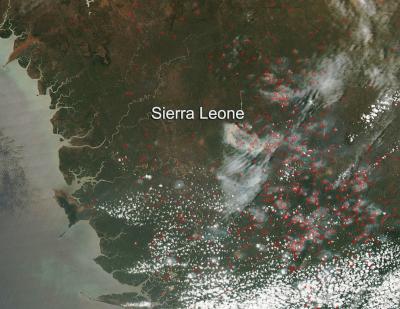Agricultural fires across Sierra Leone

Marked in red, hundreds of land use fires burn in the fields across Sierra Leone. Most fires in this region are deliberately set for a variety of reasons, including slash and burn agriculture. When a plot of land becomes exhausted, farmers shift cultivation to another plot where they cut the trees and brush at the beginning of the dry season in January and February. Once the dead plant material has dried, they set fire to it. Such fires peak in March and April right before farming season begins. Credit: NASA image courtesy Jeff Schmaltz, MODIS Rapid Response Team. Caption: NASA/Goddard, Lynn Jenner with information from Holli Riebeek.
Most fires in this region are deliberately set for a variety of reasons, including slash and burn agriculture.
When a plot of land becomes exhausted, farmers shift cultivation to another plot where they cut the trees and brush at the beginning of the dry season in January and February.
Once the dead plant material has dried, they set fire to it. Such fires peak in March and April right before farming season begins.
From space, MODIS detects thermal anomalies, including fires, flares, and volcanoes. Each MODIS “fire pixel” or fire detection covers one square kilometer, which means that one or more fire is burning in the corresponding one-square kilometer area on the ground.
There are hundreds of fire pixels evident in this image, so there are at least that many distinct fires burning in this scene. MODIS tends to undercount fires because it can't detect fires through smoke or clouds, nor does it see small cool fires—a fire type common to land use fires.
Where there is fire, there is also smoke–affecting air quality. Smoke contains soot and other particulates that pose a threat to human health and affect regional climate. Burning also releases greenhouse gases.
This natural-color satellite image was collected by the Moderate Resolution Imaging Spectroradiometer (MODIS) aboard the Aqua satellite on March 24, 2014. NASA image courtesy Jeff Schmaltz, MODIS Rapid Response Team. Caption: NASA/Goddard, Lynn Jenner with information from Holli Riebeek.
Media Contact
More Information:
http://www.nasa.govAll latest news from the category: Ecology, The Environment and Conservation
This complex theme deals primarily with interactions between organisms and the environmental factors that impact them, but to a greater extent between individual inanimate environmental factors.
innovations-report offers informative reports and articles on topics such as climate protection, landscape conservation, ecological systems, wildlife and nature parks and ecosystem efficiency and balance.
Newest articles

Sea slugs inspire highly stretchable biomedical sensor
USC Viterbi School of Engineering researcher Hangbo Zhao presents findings on highly stretchable and customizable microneedles for application in fields including neuroscience, tissue engineering, and wearable bioelectronics. The revolution in…

Twisting and binding matter waves with photons in a cavity
Precisely measuring the energy states of individual atoms has been a historical challenge for physicists due to atomic recoil. When an atom interacts with a photon, the atom “recoils” in…

Nanotubes, nanoparticles, and antibodies detect tiny amounts of fentanyl
New sensor is six orders of magnitude more sensitive than the next best thing. A research team at Pitt led by Alexander Star, a chemistry professor in the Kenneth P. Dietrich…





















